
|
Traces That Remain:
A Pictorial History of the Early Days of the Bahá'í Faith among the Japanese
by Barbara R. Sims
edited by Sheridan Sims  |
chapter 2 | start page | single page | chapter 4 |  |
Chapter 3
Mr. Kanichi Yamamoto has the distinction of being the first Japanese Bahá'í. He was born in Tosaki, Yamaguchi Prefecture, in 1879. In the very early 1900s he immigrated to Hawaii, which was then a territory of the United States. He found work in the home of Mr. and Mrs. William Smith in Honolulu. The Smiths' son, Clarence, had learned of and accepted the Faith through Miss Agnes Alexander. In the Smiths' home lived Miss Elizabeth Muther. After Miss Muther became a Bahá'í she longed to tell Mr. Yamamoto of the Faith.
Mr. Yamamoto was raised as a Buddhist but he had become a Christian and was trying to live a Christian life. He told Miss Muther that it was lonely because he was the only Christian among his Japanese friends.
Mr. Yamamoto accepted the Faith almost immediately. His English at the time was limited but he said he knew it was the Truth in his heart.
It was 1902 and he was just 23. Two years later Mr. Yamamoto went to Oakland, California to work in the home of Mrs. Goodall. Four years later he was married to a young woman, Ima, who had come to California from Japan to marry him. There is no record that Ima became a Bahá'í, but she was part of the community, a pretty, sweet woman whom everyone liked.
Most of the meetings in that area were held in the Goodall home and the Yamamotos helped to take care of the guests and made everyone feel welcome.
The Yamamoto family eventually moved to Berkeley, California. The children attended Bahá'í children's classes given by Mrs. Kathryn Frankland. It was she who first taught Mr. Saichiro Fujita, who was the second Japanese to embrace the Teachings of Bahá'u'lláh.
When Mr. Yamamoto first became a Bahá'í he wrote to 'Abdu'l-Bahá of his acceptance of Bahá'u'lláh as the Manifestation
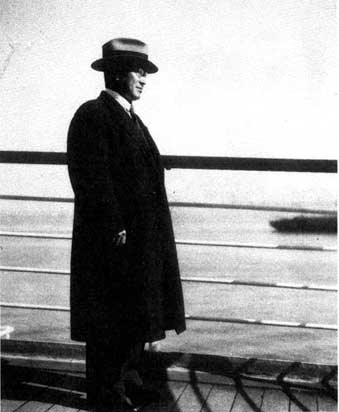
Mr. Kanichi Yamamoto. "0 thou ... unique one of the extreme Orient!" ('Abdu'l-Bahá, 1904) This photograph was taken about 1939.
for this day. He felt that his English was so poor that he could not write his letter in that language so he wrote it in Japanese. Of course, no one in the Holy Land could read Japanese. It is recorded by 'Abdu'l-Bahá's secretary that 'Abdu'l-Bahá said He would turn to Bahá'u'lláh to be guided to answer.
The Master's answers to Yamamoto's letters, as he apparently wrote several times, were full of significance. He advised Yamamoto to bear every difficulty and hardship. 'Abdu'l-Bahá Himself taught Yamamoto. In the early days of the Faith very little was translated from the Writings of Bahá'u'lláh. 'Abdu'l-Bahá wrote many letters to the believers. These letters, because of their precious nature are called Tablets. People would write asking questions, or often they just wanted to express their love for Him. 'Abdu'l-Bahá would answer telling them how fortunate
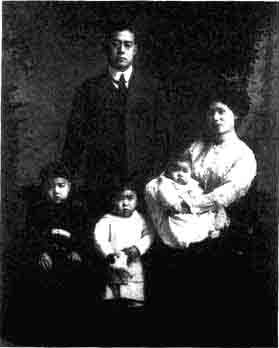
click here for larger image
Mr. Kanichi Yamamoto and his family in 1913. Hiroshi is to the left, then Shinji. Mrs. Ima Yamamoto is holding Masao.
For example, 'Abdu'l-Bahá wrote to Mr. Yamamoto, "All the sects and people ... create a God in their own minds and acknowledge him to be the creator of all things." "The Essence of the Divine Entity . . . is holy above imagination and beyond thought. Consciousness doth not reach It. ... it is a different world; from which there is no information; arrival thereat is impossible; attainment thereto is prohibited and inaccessible. This much is known. It exists...
'Abdu'l-Bahá called Mr. Yamamoto "unique". Not only was
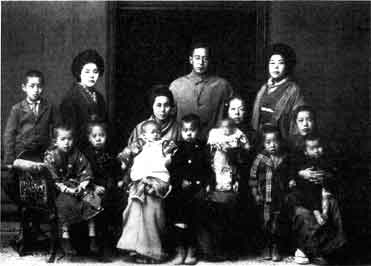
click here for larger image
This family photograph was taken in 1919 on the eve of Mr. Yamamoto's departure from Yamaguchi Prefecture to go back to the United States with four of his sons. In the back row are Hiroshi, Yamamoto's younger sister. Mr. Yamamoto and his second sister. In the front row a cousin, then Shinji (who gave us this picture), Yamamoto's oldest sister holding a baby (unidentified). Masao, Mr. Yamamoto's mother holding Fumiko, Michiaki and a relative holding Goro.
'Abdu'l-Bahá asked Mr. Yamamoto and Mr. Fujita to become the cause of the spiritual development in Japan, and He said unless man makes spiritual progress he cannot realize true material progress.
Mr. Yamamoto was indeed a cause of the spiritual development, not only of Japanese, but others as well, because now over eighty years later we are reading and pondering the answers of 'Abdu'l-Bahá to Mr. Yamamoto.
The Yamamoto line of Bahá'ís is now in the fourth generation with the birth of Michael Kanichi Yamamoto in 1979, named after his esteemed great-grandfather. The Japanese community owes thanks and gratitude to Mr. Kanichi Yamamoto — the first of his race to arise for Bahá'u'lláh in this day.

click here for larger image
This photograph was taken in 1937 and shows Yamamoto with his wife, Tame. In the back row are the children by his first wife, Ima, who died after the birth of Fumiko. From the top left are Masao, Shinji, Hiroshi, Michiaki, Goro and Fumiko.
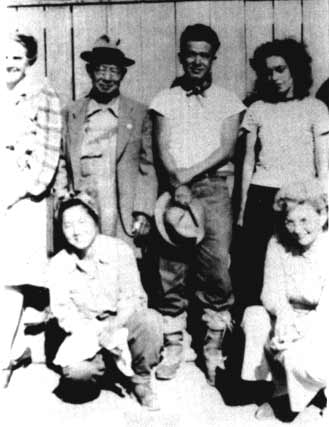
May 1942, Parlier, California, near an Assembly Center established by the U.S. military to process Japanese-Americans forcibly evacuated from the Pacific coast at the outset of WWII. The Yamamoto family had been obliged to relocate to Parlier, and later in 1942 most of the family were sent to a Relocation Center, or permanent internment camp, at Gila River, Arizona, where they stayed for the duration of the war. Ironically, one son, Masao, served in the U.S. armed forces during that time.To the left is Mrs. Ramona Allen Bray (later Brown), and to the right Mrs. Marzieh Gail, both renowned Bahá'í writers. Mr. Kanichi Yamamoto is standing with his son Goro, and daughter Fumiko is kneeling. Kneeling on the right is Mrs. Margaret Cavanaugh, sister of the compiler.
Mrs. Bray, Mrs. Gail, Mrs. Cavanaugh and Mr. Robert Gulick (who took the picture), stopped by to see the Yamamotos on their way back to Berkeley, California after attending the National Convention in Chicago. The Yamamotos were also from Berkeley.
At Parlier they had to work in the fields. Mrs. Cavanaugh recalls how Fumiko's hands were cracked and red from the heavy work which she was unaccustomed to doing.
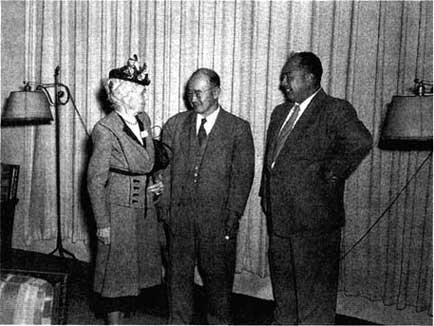
Mrs. Kathryn Frankland greets her dear old friends, Mr. Kanichi Yamamoto and his oldest son Hiroshi, at the American National Bahá'í Convention in 1948.
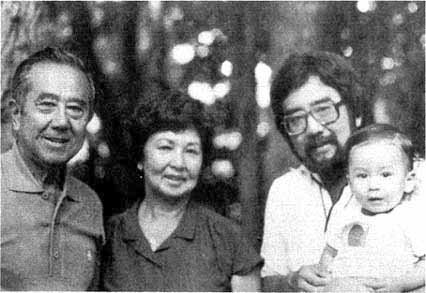
Three generations of Bahá'ís. Mr. Shinji Yamamoto and his wife Hifumi. Their son, Dr. Stephen Yamamoto is holding little Michael Kanichi. This was taken in the United States in 1980.
Mr. Saichiro Fujita, 1886-1976
Mr. Fujita went to the United States when he was just a teenager as he wanted to complete his education there. While he was in school, he went to work in the home of Mrs. Kathryn Frankland. She had a great love and affinity for the Japanese and had also helped to teach Mr. Yamamoto and his children.
Mr. Fujita accepted the Faith in 1905. The American Bahá'ís had trouble pronouncing Fujita's name so while there he took the first name, Harriston, but that was eventually dropped and
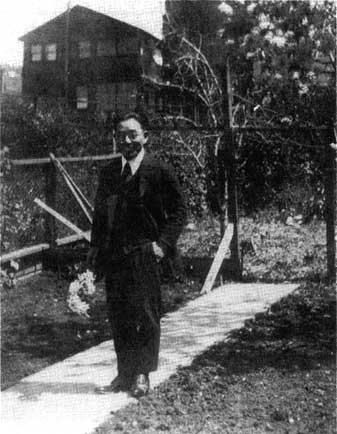
17
When 'Abdu'l-Bahá made His trip to America, Fujita met Him in Cleveland, where he was staying with some Bahá'ís. 'Abdu'l-Bahá invited Fujita to travel with Him, so Fujita joined the group. Fujita expressed the desire to return to the Holy Land with 'Abdu'l-Bahá, and spend the rest of his life serving Him.
'Abdu'l-Bahá accepted Fujita's offer but for the next seven years guided Fujita's studies in the United States for the special services that he would do in the Holy Land. In 1919 Fujita left for the Holy Land and stayed until 1938. He helped in many ways; he maintained 'Abdu'l-Bahá's car; he installed some of the electric wiring; he assisted in making the gardens beautiful; he took good care of the pilgrims.
Perhaps one of his greatest services was at the saddest time in his life, just after the passing of 'Abdu'l-Bahá in 1921. 'Abdu'l-Bahá's sister, Bahiyyih Khanum, known as the Greatest Holy Leaf, took over the affairs of the Faith until Shoghi Effendi returned to Haifa to assume his duties as Guardian of the Faith. As Fujita's English was fluent, he wrote letters at the direction of the Greatest Holy Leaf. It was Fujita who informed the Japanese Bahá'ís of events at that critical time. Some of those letters written by Fujita on behalf of the Greatest Holy Leaf are
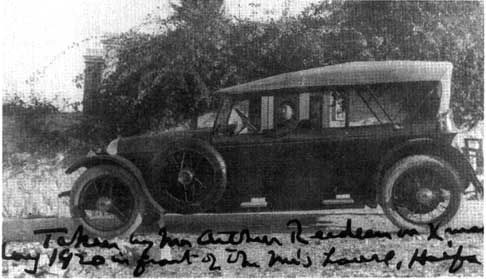
1920. Fujita sitting at the wheel of 'Abdu'l-Bahá's automobile. He accompanied this automobile from the United States to the Holy Land in 1919.
After the passing of 'Abdu'l-Bahá, Fujita served the Guardian with the same love and zeal as he had 'Abdu'l-Bahá. The Guardian was concerned about the safety of Fujita as the clouds of World War II loomed, and arranged for him to return to Japan in 1938 to live with his family in Yamaguchi Prefecture.
In 1955 the Guardian permitted him to return to the Holy Land. Fujita received the good news via the Tokyo Local Spiritual Assembly. He wrote to the Tokyo Assembly that it was the greatest joy and happiness of his life to be able to return to the Holy Land. Shortly after his participation at the Nikko Conference he left Japan.
His loving and humorous nature was the cause of delight of numerous pilgrims. Some of us met him in the Holy Land in the later years where he was actively serving the Universal House of Justice. He said he was sometimes lonesome but we understood that he was not lonesome for Japan, but for the Master and for the Guardian.
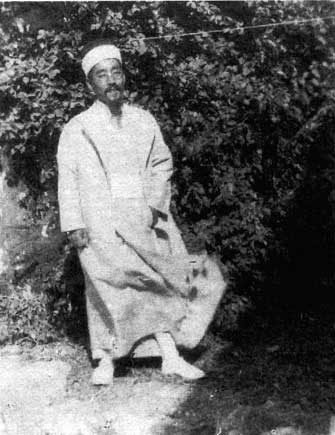
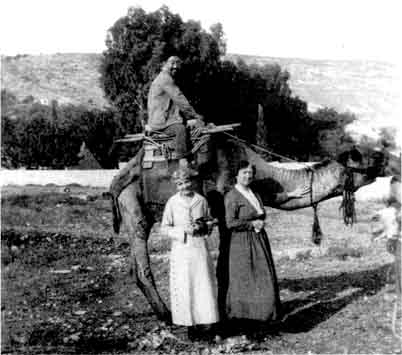
click here for larger image
Riding a camel in front of the Pilgrim House in Haifa. The ladies were unidentified but the one on the left looks like Mrs. Frankland.

click here for larger image

1968. Fujita was happy to see National Spiritual Assembly members from Japan during the 1968 International Convention in the Holy Land, when this photograph was taken.
Mr. Torikai received one Tablet from 'Abdu'l-Bahá who urged him to illumine his own land (Japan). Only that much is known of the Tablet as no copy remains. Mr. Torikai visited Japan in 1916/17, met Miss Alexander and Mr. Torii, and formed a friendship with them. During that trip he wrote the first original
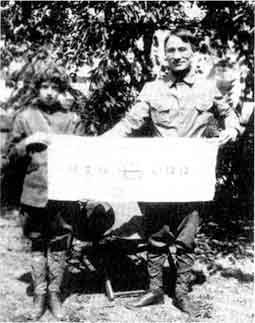
click here for larger image
The above photograph of Mr. Torikai was taken the summer of 1917 when he returned to Seattle after a visit to Japan. He sent it to the Bahá'ís in Japan. The banner says "Bahá'í Shin Bunmei" (Bahá'í New Civilization).
pamphlet in Japanese. Previous ones were translations. It was called "Sekai Shin Bunmei" (New World Civilization). This pamphlet was spread about Japan.
Mr. Torii transcribed part of the pamphlet into Japanese Braille, combining it with other material and used it as a text for Braille classes which he taught. It was called "Motomeyo Saraba Ataeraren" (Seek and It Shall Be Given You). It was the first Japanese Braille Bahá'í pamphlet.
Mrs. Torii recalls that Mr. Torikai travelled from Tohoku to Kyushu speaking of the Faith. He would wear a headband on which was written "Jinrui Goitsu" (Oneness of Mankind) in Japanese. He also carried a banner which he would spread out.
Mr. Torikai went to Peru to live in the 1920s and as there was no Bahá'í activity there in those early days, he lost track of the Bahá'ís. Eventually he came back to Japan, where he died. We were able to find some of his relatives. His cordial wife, Yoshie, who was considerably younger than her husband, said if he had been able to see any Bahá'ís in Japan in the later years it would have made him very happy.
 |
chapter 2 | start page | single page | chapter 4 |  |
|
|